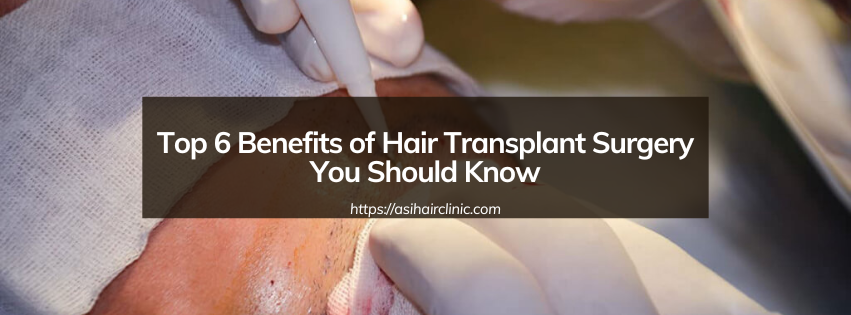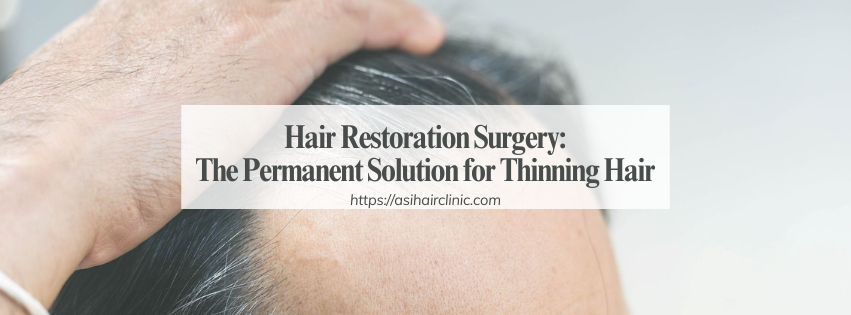When should Hair Loss be taken Seriously?
Hair loss is a common concern that affects many individuals, irrespective of age or gender. Like other natural bodily processes, hair has its own growth cycle and shedding is a normal part of that. However, understanding the nuances of hair loss can enable us to discern when it becomes a more serious health issue requiring attention. Knowing when to seek professional help can not only alleviate distress but also lead to effective treatment options that may restore hair and confidence.
1. Understanding normal hair loss
Before we explore when hair loss should be taken seriously, it's crucial to grasp the intricacies of normal hair shedding and the natural hair growth cycle.
The human scalp typically contains around 100,000 hair follicles, each undergoing a cyclical process consisting of three phases:
- Anagen Phase (Growth Phase): This phase can last several years and is where hair grows actively.
- Catagen Phase (Transition Phase): Lasting a few weeks, this stage signals the end of growth and the hair follicle begins to shrink.
- Telogen Phase (Resting Phase): This is when hair rests for about three months before eventually being shed. At any given time, around ten to fifteen percent of our hair is in this resting phase.
On average, shedding between 50 to 100 strands daily is generally considered normal. Such variability can be influenced by numerous factors including genetics, hormonal changes, stress levels, and medications. During periods of significant physical or emotional stress, you may experience an uptick in shedding; however, this is often temporary, with hair regrowth returning over time.
As we delve deeper into the complexities of hair loss, we will examine certain signs and symptoms that indicate the need for a closer look, as well as potential underlying causes and effective treatments. 2. Signs that indicate hair loss needs attention
2. Signs that indicate hair loss needs attention
While some degree of hair loss is normal, certain indicators may suggest that your situation requires professional evaluation. Recognizing these signs can enable timely intervention, which could mitigate further loss and address any underlying health conditions.
2.1. Excessive hair shedding
It’s expected to lose some hair every day, but if you find yourself noticing significantly more hair than usual on your brush, in the shower, or on your pillow, it's time to take a step back and evaluate.
Excessive shedding can be a sign of various conditions, including androgenetic alopecia, commonly known as male or female pattern baldness. This hereditary condition gradually reduces both the density and thickness of hair. Another possible culprit is telogen effluvium, which represents a sudden increase in hair shedding due to stress, illness, or drastic weight changes. Understanding the root of excessive shedding is essential to determine an effective treatment plan.
If you feel overwhelmed by the amount of hair you are losing, documenting the shedding patterns over a week can provide valuable information to share with a healthcare professional. Taking photographs and keeping a record of your hair loss can help facilitate a more informed diagnosis.
2.2. Receding hairline or thinning at the crown
A receding hairline, particularly noticeable in men, or thinning hair at the crown of the head can serve as red flags signaling androgenetic alopecia. Genetic predispositions often dictate this form of hair loss, where testosterone-related hormones cause hair follicles to shrink over time.
Recognizing a receding hairline can be challenging, especially if it happens gradually. Observing family history plays an important role in determining risk, as those with relatives who have experienced hair loss are statistically more likely to face similar challenges. If you start noticing thinning at the temples or crown, don’t hesitate to consult with a dermatologist who specializes in hair loss.
Additionally, aesthetic concerns should not be overlooked. The psychological impact of a receding hairline can significantly affect self-esteem and confidence, leading to social withdrawal or anxiety. Seeking treatment early can counteract these effects and improve overall quality of life.
2.3. Sudden or patchy hair loss
A sudden loss of hair or patchy areas, medically referred to as alopecia areata, can be alarming. This autoimmune disorder manifests when your immune system mistakenly attacks hair follicles, causing hair to fall out in specific regions.
Individuals suffering from alopecia areata often describe feeling a sense of shock or despair upon discovering bald patches. The emotional toll can be substantial, as it may lead to feelings of helplessness. In such situations, reaching out to support groups and healthcare professionals can prove invaluable.
Moreover, alopecia areata may resolve spontaneously in some cases, but for others, it may require treatment. Corticosteroids, topical therapies, or light therapy can be prescribed based on the severity of hair loss. Consulting with a dermatologist will provide a tailored approach for managing this distressing condition.

2.4. Changes in hair texture or appearance
Changes in the texture or appearance of your hair should never be ignored. Brittle, dry, or lackluster hair can provide clues about underlying issues affecting hair health.
Several medical conditions can alter hair's natural state. For instance, hypothyroidism can lead to coarse and brittle hair due to decreased hormone production. Nutritional deficiencies in vital nutrients such as iron, zinc, and biotin can also manifest through poor hair quality, reflecting an unhealthy scalp environment.
Consequently, maintaining a nutritious diet rich in vitamins and minerals is essential for promoting optimal hair health. If you notice significant changes accompanied by other symptoms like fatigue or mood swings, schedule an evaluation with your healthcare provider. They may recommend blood tests to assess nutritional levels or thyroid function.
2.5. Itching, scalp irritation, or redness
Persistent scalp issues-such as itching, irritation, or redness-can point toward an underlying condition, potentially affecting hair growth. Fungal infections like tinea capitis (ringworm) or conditions such as scalp psoriasis provoke inflammation, damaging hair follicles.
Understanding the relationship between scalp health and hair loss is pivotal. An inflamed or irritated scalp can impede the normal growth cycle of hair, exacerbating shedding and thinning. If you experience discomfort associated with hair loss, seeking a dermatologist's opinion is highly recommended. Treatments may include antifungal shampoos, topical steroids, or prescription medications aimed at alleviating inflammation.
2.6. Unusual hair loss patterns
Observing unusual hair loss patterns that deviate from typical androgenetic alopecia signs warrants further investigation. For example, localized shedding or irregular patches may suggest another health condition, including infections or dermatologic disorders.
Documenting your hair loss pattern can aid your dermatologist in forming an accurate assessment. Treatment options might vary drastically depending on the cause, making it essential to clarify any atypical presentation.

3. Potential underlying causes of hair loss
The spectrum of hair loss is vast, encompassing a myriad of underlying medical conditions and lifestyle factors. By identifying these potential causes, one can effectively tackle the problem at its root.
3.1. Hormonal imbalances
Hormonal fluctuations are integral to the hair growth cycle. Events such as pregnancy, childbirth, menopause, or thyroid disorders can lead to significant changes in hair growth patterns.
For example, during pregnancy, elevated estrogen levels extend the anagen phase, often resulting in thicker hair. Conversely, postpartum hair loss occurs due to reduced estrogen levels, triggering many hair follicles to enter the telogen phase simultaneously. These shifts can result in marked shedding post-delivery.
Thyroid conditions-both hyperthyroidism and hypothyroidism-can disrupt hair growth cycles, leading to thinning or shedding hair. A thorough examination of hormonal levels may help identify imbalances that necessitate treatment, leading to improved hair growth and overall health.
3.2. Nutritional deficiencies
Inadequate intake of essential nutrients can precipitate hair loss. Nutrients such as iron, zinc, vitamin D, and biotin play crucial roles in supporting healthy hair growth.
Iron deficiency anemia can lead to hair thinning, as iron is responsible for oxygen delivery to hair follicles. Similarly, a lack of zinc can affect protein synthesis, essential for strong, resilient hair. Each nutrient contributes uniquely to hair health, so ensuring a balanced diet rich in vitamins and minerals is fundamental in preventing deficiencies that could harm hair growth.
However, while dietary changes are beneficial, they're often insufficient for reversing existing hair loss. Consultation with a nutritionist or healthcare provider can help tailor a supplement regimen addressing specific deficiencies, ultimately enhancing hair vitality.
3.3. Medications and medical treatments
Certain medications-including chemotherapy drugs, anticoagulants, and antidepressants-are known to induce hair loss as a side effect. Chemotherapy, in particular, targets rapidly dividing cells, inadvertently affecting hair follicles and leading to significant hair loss.
If you suspect your medication may be contributing to hair loss, discuss alternatives with your physician. Sometimes, adjusting the dosage or switching medications can mitigate side effects while still addressing the original health concern.
Medical treatments such as radiation therapy can also lead to hair loss in the affected area. Awareness of these potential side effects can empower patients to make informed decisions regarding their health care choices.
3.4. Autoimmune disorders
Autoimmune disorders like alopecia areata, lupus, and thyroid disease can be implicated in hair loss. In these cases, the body mistakenly attacks its own tissues, including hair follicles, leading to thinning or patchiness.
Raising awareness about the autoimmune component of hair loss is critical for early identification and treatment. Support systems, including mental health resources, may be helpful for those dealing with the emotional aspects of these challenging conditions.
3.5. Stress and anxiety
Prolonged stress and anxiety can cause hair to enter the telogen phase prematurely, resulting in a type of hair loss known as telogen effluvium. Though often temporary, the psychological burden of stress-induced hair loss can exacerbate feelings of anxiety and insecurity.
Implementing techniques to manage stress-such as mindfulness practices, exercise, or therapy-can promote overall well-being and contribute to healthier hair growth. Addressing stressors holistically enhances not just hair health, but overall life satisfaction.

3.6. Scalp infections
Fungal infections like tinea capitis and bacterial infections can lead to inflammation and subsequent hair loss. Detecting and treating infections promptly can prevent long-term damage to hair follicles.
If you suspect an infection, consulting a dermatologist is essential. Treatments may involve antifungal medications or topical antibiotics designed to eradicate the infection and restore scalp health.
3.7. Genetic predisposition
Androgenetic alopecia remains the most prevalent form of hair loss, primarily influenced by genetic factors. Those with a family history of hair loss are statistically more inclined to experience similar outcomes.
Understanding your familial predisposition equips you with knowledge on preventive measures. Early intervention strategies can include lifestyle changes or medications to slow down the hair loss process, enabling better management throughout life.
3.8. Aging
As we age, natural biological processes lead to the gradual thinning of hair. Hair follicles produce fewer strands over time, resulting in finer, less dense hair. While this change is natural, recognizing its impact on self-image is vital.
Embracing aging gracefully involves adopting nourishing practices to maintain hair health. Utilizing gentle shampoos, conditioning regularly, and incorporating scalp massages can enhance circulation and stimulate follicles for optimal hair growth.
4. When to see a doctor
Identifying concerning hair loss signs is imperative. If you are experiencing any of the previously mentioned symptoms, scheduling an appointment with your healthcare provider or a dermatologist is essential. Early evaluation facilitates the possibility of intervention, significantly improving the chances of preserving hair.

4.1. Diagnostic tests and procedures
When assessing hair loss, healthcare professionals utilize various diagnostic tools to ascertain the cause and formulate a targeted treatment plan.
- Physical examination: The initial step typically involves a visual examination of the scalp and hair to assess the extent and pattern of hair loss. Observations made during this process provide invaluable insights essential for diagnosis.
- Medical history: Reviewing personal and family medical histories aids healthcare providers in understanding potential genetic influences on hair loss. Sharing information about current medications and previous medical conditions can unveil underlying causes.
- Blood tests: Blood tests can reveal hormonal imbalances, nutritional deficiencies, or other medical conditions contributing to hair loss. Testing for thyroid function, iron levels, and hormone profiles provide critical data for accurate diagnoses.
- Scalp biopsy: In some instances, performing a scalp biopsy-where a small sample of skin is examined under a microscope-helps identify autoimmune disorders or infections affecting hair follicles.
- Pull test: A simple pull test involves gently tugging the hair to assess how many strands come out easily, which quantifies the severity of shedding. Understanding the rate of hair loss can guide treatment decisions.
- Hair microscopy: Microscopically examining hair shafts provides insight into their structure, helping identify damage or breakage that may not be visible to the naked eye.
4.2. Treatment options for hair loss
Once a diagnosis is obtained, the appropriate treatment options depend on the underlying cause and severity of the hair loss.
- Medications: Medications such as minoxidil and finasteride are FDA-approved for use in androgenetic alopecia. Minoxidil, available as a topical solution, promotes hair regrowth, while finasteride blocks hormone receptors that contribute to hair loss.
- Topical treatments: Creams, lotions, and shampoos containing corticosteroids or antifungal agents can treat scalp infections and inflammation. These topical solutions aim to restore scalp health and promote optimal hair growth.
- Platelet-Rich plasma (PRP) therapy: PRP therapy involves injecting platelet-rich plasma derived from the patient’s blood into the scalp. This innovative procedure stimulates hair follicles and encourages hair regrowth, thereby providing promising results for individuals facing thinning hair.
- Hair transplantation: Surgical hair transplantation involves moving hair follicles from one area of the scalp to another, commonly used for androgenetic alopecia. This option can yield permanent results, though it requires careful consideration and evaluation.
- Low-Level light therapy (LLLT): This non-invasive treatment employs low-level laser light to stimulate hair follicles, encouraging hair growth. LLLT offers a painless and drug-free alternative for individuals seeking to retain hair density.
- Lifestyle changes: Integrating lifestyle changes can significantly bolster hair health. Consuming a balanced diet rich in essential nutrients, managing stress levels, and avoiding harsh hair treatments contribute to healthier hair.
Conclusion
Navigating the complex landscape of hair loss can be overwhelming, yet recognizing the signs and seeking timely medical attention can dramatically alter the course of your experience. Differentiating between normal shedding and excessive hair loss is pivotal in determining whether intervention is necessary.
With a range of potential causes, understanding the underlying factors at play allows for effective diagnosis and treatment. Whether hormonal imbalances, nutritional deficiencies, or stress-related triggers are involved, timely action can lead to successful management, retaking control over your hair health.
If you find yourself grappling with concerning hair loss, don't hesitate to consult a healthcare professional. They can provide personalized recommendations, helping you reclaim your confidence and embrace vibrant, healthy hair.
LATEST POSTS








